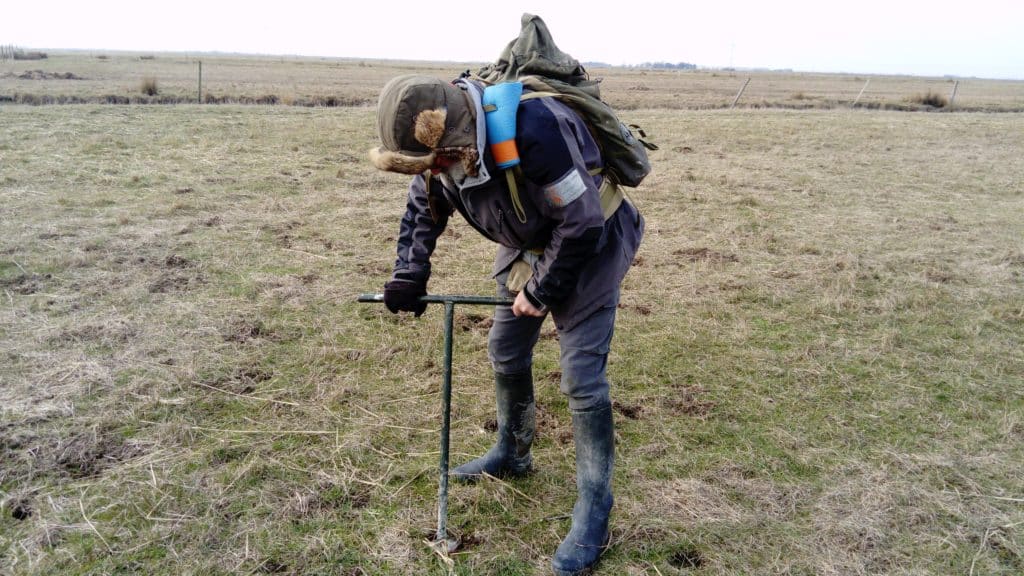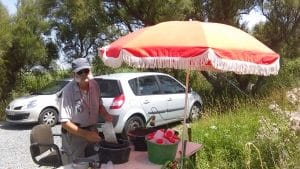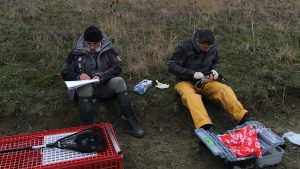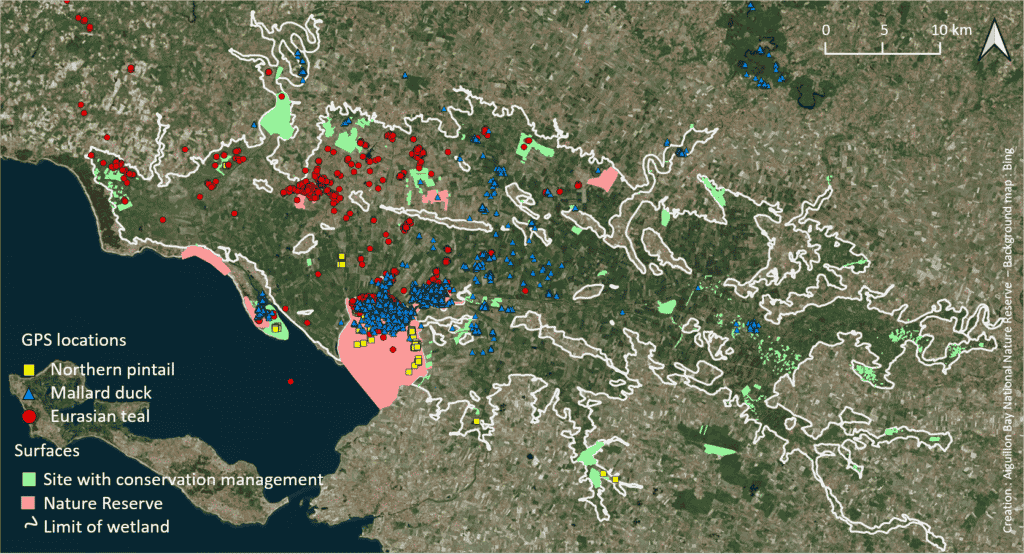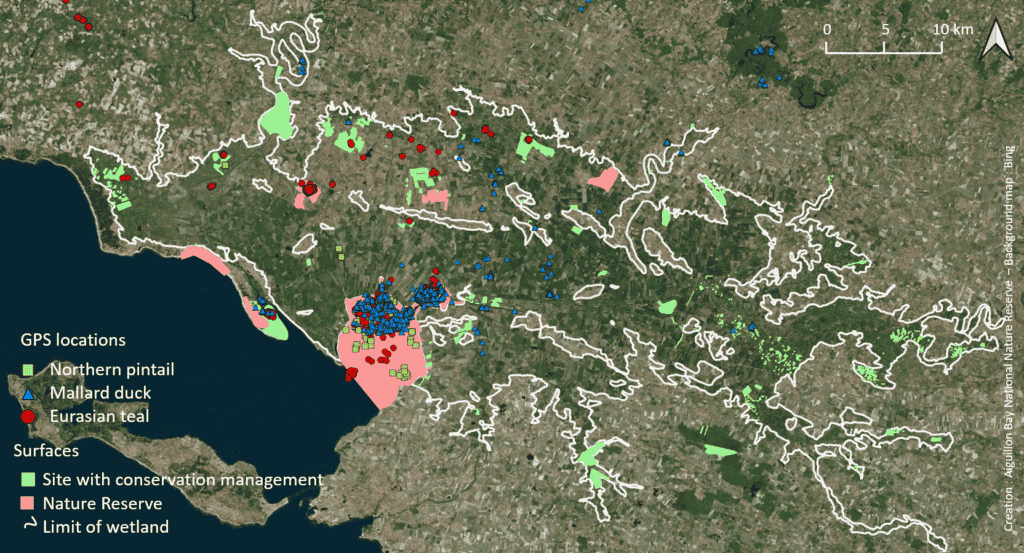Study of the use of the Aiguillon Bay and peripheral marshes by wintering wildfowl.
REASON FOR SUCH A STUDY?
The Aiguillon Bay and the Marais Poitevin are essential areas for many migrant and wintering wildfowl. In the 1980s, this eco-complex held more than 80,000 dabbling ducks. Due to agricultural changes in the marsh (reduction of area of grassland and modified hydraulic management), this number is currently around 20,000 birds. All the main loafing areas are classified as nature reserves, but not all feeding areas are strongly protected. On the face of it, the main loafing areas are included within the perimeter of the Natura 2000 zone. Contracts concerning agro-environmental measures (AEMs) are offered to farmers to maintain grassland habitats.
For this reason, it is important to create or improve loafing areas on the edge of the bay, areas located outside the perimeter of the National Nature Reserve. Given the complexity of agricultural and hydraulic policies in the Marais Poitevin, it seems essential to target the areas for action on both the terrestrial and the coastal parts.
But, beyond this work, one of the conservation challenges of this cortege of waterfowl species is to have a better understanding of the links between the feeding areas and the loafing areas, and thus better understand the functional space for these ducks. The work carried out will therefore have an operational character in order that management of the Marais Poitevin is adapted to ensuring that the wetlands are favourable for waterfowl. The corridors that accompany this work will thus help in the implementation of public protection policies.
The work carried out under the LIFE Baie de l'Aiguillon project concerns only food resources and related habitats. So three questions predominate: where do wildfowl loafing in the bay go to feed, what do they eat and what evolution is there of food resources?
Several species overwinter in the bay, the more numerous of which are Mallard Anas platyrhynchos (nearly 7000 in 2016), Teal Anas crecca (3400 in 2016), Wigeon Anas penelope (2800 in 2016), Pintail Anas acuta (2000 in 2016) and Shoveler Anas clypeata (400 in 2016).
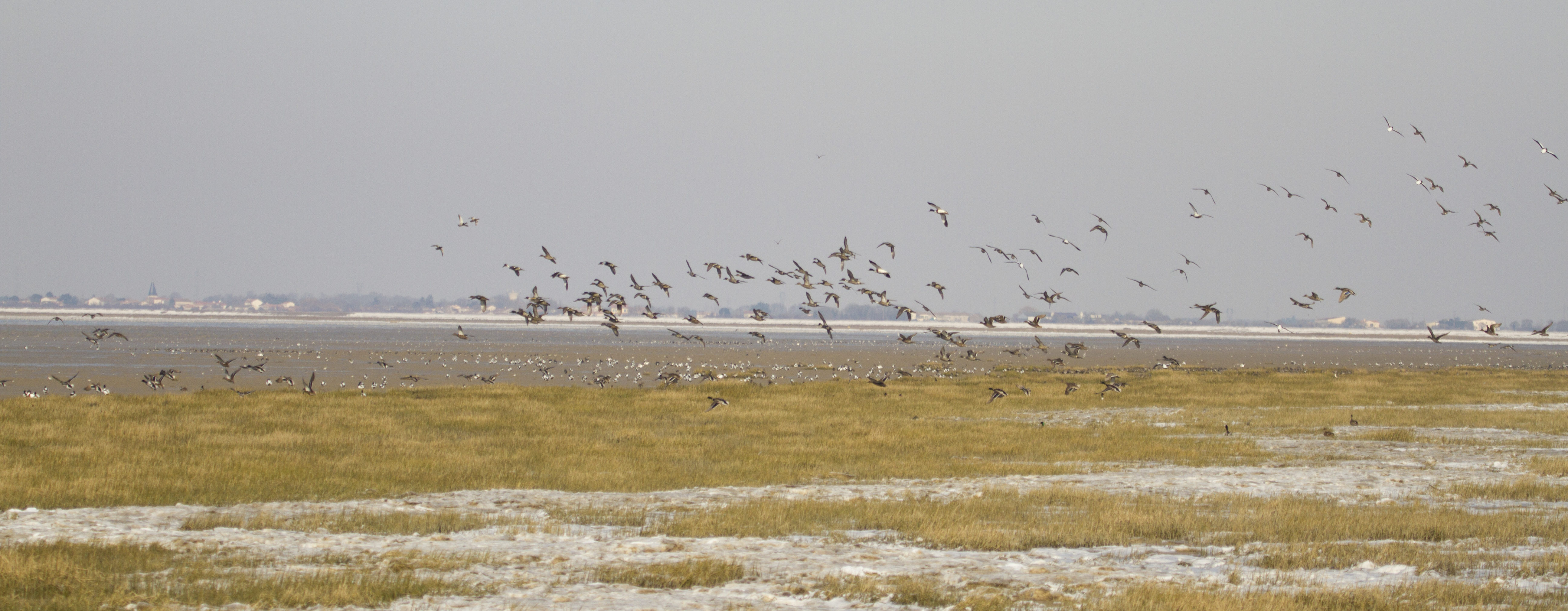
Flight of wildfowl over the nature reserve © BEQUARD
WHAT SHOULD BE DONE?
1 - First question: which areas produce the most food?
The aim is to characterize and quantify the main trophic resources for granivorous wildfowl through the analysis of seeds contained in soil core samples. These analyses allow us to qualify and quantify the main seeds consumed by the wildfowl. They also identify the potential of the site from surface samples taken throughout the season (in the autumn, before the arrival of the wintering birds; in winter, while they are presence; in the spring, at the end of the season).
Several feeding areas with different characteristics will be sampled: Marais de la Vacherie at Champagné-les-Marais, Charron and Champagné salt marshes, Lairoux common land, Prée Mizottière.
Seed analysis is then done by sifting the core samples. Each seed is identified and counted. The total seed weight of each core sample is noted (fresh and dry weights).
2 - Second question: what do the ducks eat?
In cooperation with local hunters practicing two different hunting methods (“la passée” – as birds fly by in the early morning or evening, or “à la tonne” - from a sort of blind), crops of shot ducks will be analysed. This in order to discover what ducks eat during the winter.
The following species are concerned by these analyses: Teal Anas crecca, Mallard Anas platyrynchos, Gadwall Anas streptera, Pintail Anas acuta and Shoveler Anas clypeata.
This analysis concerns only wintering ducks killed during hunting in December and January, preferably during the “passée”. Each gizzard and crop was placed in a freezer bag. A label made by reserve staff is given to voluntary hunters.
Various local hunting groups «Fédération Départementale des Chasseurs de Vendée", "La Sauvagine Vendéenne" and "La Chasse Maritime Vendéenne » are closely associated with this part of the study.
3 – Third question: where do they go to feed?
This study requires the capture of Mallard and Teal. The choice of species was made to equip ducks considered to be granivorous. These ducks are equipped with GPS-type emitters in order to specify the location of feeding areas and the movement of ducks during the night.
This action took place during the 2016-2017, 2017-2018 and 2018-2019 seasons.
The results will therefore provide information in order to:
- assess the ecological performance of LIFE projects. It will then be possible to characterize the distribution at night and therefore the "functional" use (feeding) of the sites that have been the subject of an intervention (removal of oyster beds, installation of hydraulic management structures) whether on the mudflats (potentially used by the Pintail) or on the Prée Mizottière site (effect of hydraulic management).
- have some understanding on the use of the Marais Poitevin’s trophic resources by anatidae and thus to spatially target their needs in terms of protection both on the roosting sites and on the feeding sites.
At first, it is easier to catch these birds at Prée Mizottière. Nevertheless, experiment captures on the bay (more random) were tested during the 2017-2018 winter resulting in the Champagné-les-Marais salt marshes being retained as a capture site.
This action therefore integrates "capture and ringing", equipping birds with transmitters and geo-locality analysis of the data. It is therefore a question of recovering the precise GPS location of the ducks to identify their feeding area (and their associated management).
Due to it being specifically focused on ducks, this programme phase will be integrated into the "Teal" programme of the OFB (The French Biodiversity Agency).
Capture and ringing
Ducks were caught at the Prée Mizottière, l’Epine, the Le Petit-Rocher sites as well as on the Champagné-les-Marais salt marshes, using cage traps. Catching operations at the Pointe d'Arçay took place during the 2018-2019 winter. Grain was distributed in traps to optimize their efficiency.
The cage traps are deployed every day from mid-November to mid-January (NB: given the training constraints, they were only in use from the beginning of December in 2017); all captured ducks are ringed. Teal are equipped with nasal markings. This additional system facilitates the implementation of the LIFE programme as all the necessary authorizations and technicalities have been validated by the Natural History Museum at the OFB. All training related to ringing and the installation of transmitters will be done in this context.
RESULTS
Le final report is available to download here : Lagrange P (2022) Etude sur l’utilisation de la baie de l’Aiguillon et des marais périphériques par les anatidés hivernants
1 – First question: which are the areas that produce the most food?
To answer this first question, nearly 12,150 core samples were taken from all the sites during the 3 years of sampling (salt marsh grass areas of Charron and Champagné-les-Marais, meadows of the Prée Mizottière and the Vacherie and Lairoux common marshes). All the core samples were sieved, and the seeds placed in an oven (4 days at 60 ° C) before the analysis phase: identification, counting and weighing.
The seed bank is at first sight more diversified in wet meadow than in salt meadow, but this variability is dependent on the year and the season and more linked to the sampling site (larger sample in the meadow environment than in salt meadow) than to the habitat.
In total, 82 genera were found in wet meadow against 54 in salt meadow. Salt meadows are dominated by the genera Salicornia, Puccinellia, Suaeda, Atriplex, Parapholis and wet meadows by Trifolium, Ranunculus, Carex, Eleocharis and Polygonum.
2 – Second question: what do the ducks eat?
To answer this question, 69, 25 and 56 gizzards/crops (first, second and third years respectively) of different species of granivorous anatidae were analyzed: Mallard, Teal, Wigeon, Pintail and Shoveler.
Plant debris was found in 50% of Eurasian wigeon, 32% of shovelers and mallards, 25% of pintails, 1% of Eurasian teals and none in the two gadwalls sampled.
The ten taxa found most frequently in the gizzards that made up the diet of Anatidae (all species combined) were: Eleocharis palustris (37% of individuals had ingested it), Chironomidaea (27%), glasswort (19% ), Persicaria hydropiper (19%), Carex vulpina and C. cuprina (respectively 15 and 10%), Puccinellia maritima (8%), Trifolium arvense (7%), Hydrobia ulvae (6%), Medicago lupulina (6%) , Suede vera (5%).
The number of seeds collected in total is more abundant in the floristic composition of salt meadows than in the composition of wet meadows.
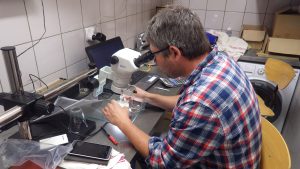
Sorting and analysis of the first Mallard gizzards

3 – Third question: where do they go to feed?
Birds were captured at Prée Mizottière, L’Epine, Le Petit Rocher and the Pointe d'Arçay (one year only) sites and on the salt marsh meadows of the reserve using several “matoles” (small traps with decoys) and one or two large cage traps.
During the first capture session (17th December 2016 to 26th February 2017), 2 Wigeon, 1 Teal and 59 Mallard (43 males and 16 females) were captured and ringed. Of these, 9 ducks were equipped with a transmitter (8 males and 1 female).
During the second capture session (11th November 2017 to 22nd February, 2018), 1 Wigeon, 27 Teal, 7 Pintail and 27 Mallard (43 males and 16 females) were captured and ringed. Of these, 14 ducks were equipped with a transmitter (5 Teal, 6 Mallard and 3 Pintail).
During the third capture session (19th November 2018 to 28th February, 2019), 40 Teal (18 males and 22 females) as well as 20 Mallard (10 males and 10 females) were captured and ringed. Of these, 34 duck were equipped with a transmitter (15 Teal and 19 Mallard).
74,967 GPS points were recorded, making it possible to track 42 individuals (all species combined) whose distribution of locations extends from the Marais poitevin to Russia.
Equipping ducks with GPS emitters made it possible to follow the Eurasian Teal, the Mallard and marginally the Northern Pintail during their wintering. We observe a dispersal of individuals at night towards feeding areas, in particular on the "communals" for teals (Magnils-Reigniers) or inland waterways for mallards (including 12% outside the Marais poitevin), whereas the individuals gather during the day on resting areas such as Prée mizottière, the Reserve of Saint-Denis-du-Payré or the Aiguillon Bay.
The Eurasian Teal preferentially used protected natural areas or areas with an environmental vocation as diurnal rest areas in January and February (in and out of the hunting season) , which is not the case on feeding sites. Conversely, the Mallard mainly frequented sites outside protected areas or areas with an environmental vocation with a higher attendance in feeding than in resting on these sites.
The Anatidae seem to generally occupy the same sectors at night as during the day, regardless of the species, but seem to be more dispersed at night. The size of the estimated home ranges is 9,793 hectares for the Mallard, with a standard deviation of 22,127 ha for the 20 Anatidae monitored over 22 winterings (wintering monitored for at least 10 consecutive days per individual). The home range of the Eurasian Teal is estimated for 11 individuals over 12 winters at 9,771 ha on average (± 18,287 ha) and that of the Northern Pintail monitored for less than 4 days for 2 individuals at 14,160 ha (± 17,921 ha).
More information in the news section.

